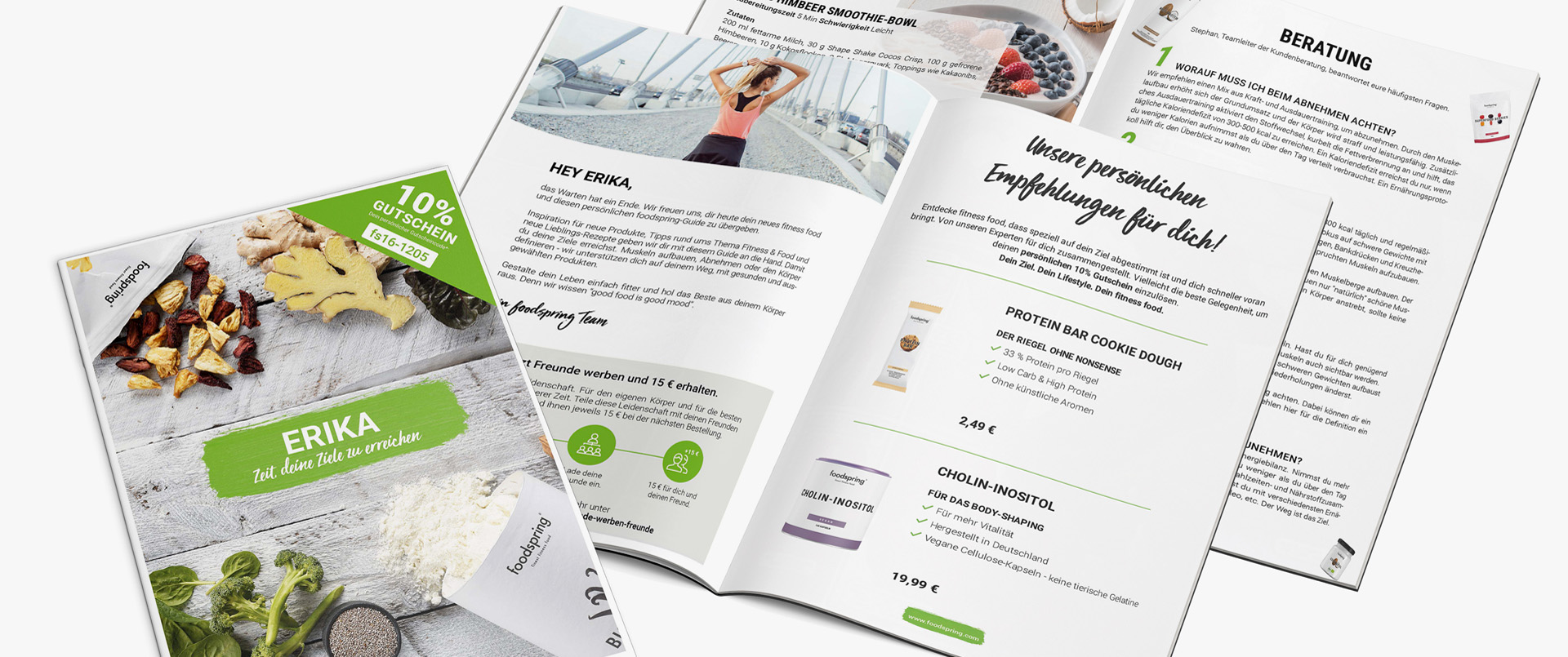Print Elevates the Unboxing Touchpoint
Panorama 3/17
In the e-commerce segment, unboxing is most likely the touchpoint on the customer journey that sparks the most emotional engagement. Such after-sales service has the potential to convert a customer from an expensive one-off buyer to a lucrative return shopper. Adnymics GmbH in Germany helps e-retailers exploit that opportunity by means of highly effective personalized package inserts. “Panorama” spoke to CEO Dominik Romer about what such a seemingly modest print product can achieve.
 Dominik Romer, CEO of Adnymics, is bringing e-commerce and print together.
“Panorama”: Where did the idea of developing a solution for the production of personalized package inserts come from?
Dominik Romer (CEO of Adnymics):
Dominik Romer, CEO of Adnymics, is bringing e-commerce and print together.
“Panorama”: Where did the idea of developing a solution for the production of personalized package inserts come from?
Dominik Romer (CEO of Adnymics): I studied print and media technology in Munich and worked in the field of dialog marketing for many years. During that time I learnt a lot about advertising production and the handling of data. Dialog marketing is reliant on data, so I looked at where high-quality data can be obtained in order to personalize printed materials with the aim of appealing to people at a particular touchpoint. The unboxing touchpoint was the obvious choice. E-retailers know a great deal about the future recipient. We provide software and hardware that enable personalized package inserts to be printed directly at the point of distribution or at the fulfillment center.
What did it take to implement the idea?
A fair amount of naivety and the willingness to take the plunge. If I had known what I was letting myself in for, perhaps I would have spent another month conducting research. The most important thing was to find people with the relevant IT expertise who I can absolutely rely on. Another critical aspect was “operations”, i.e. installation of the printing systems and customer support, which we massively underestimated at the start. However, we’re now very well positioned in that regard.
Does Adnymics see itself as a conventional startup?
Yes, in my view it is. I consider a startup to be a company that isn’t more than five years old and that creates a highly complex product from relatively little. We meet both those criteria.
 In the e-commerce segment, unboxing is most likely the touchpoint on the customer journey that sparks the most emotional engagement.
The question of financing always arises in connection with startups. How has Adnymics managed to secure financing?
In the e-commerce segment, unboxing is most likely the touchpoint on the customer journey that sparks the most emotional engagement.
The question of financing always arises in connection with startups. How has Adnymics managed to secure financing?
We would have liked to finance ourselves. However, outside financing is normally unavoidable for such a complex topic. In the meantime, we’ve secured several million euros through several rounds of financing so that we can ensure our product and technology are cutting edge. In tandem with that, we’ve established a sales and marketing team to keep the ball rolling in the longer term. We have investors on board who also help us in ways that go beyond financing. Some have an involvement in other online shops and assist us, for example, with sales and increasing our international profile.
Has the packaging touchpoint been underestimated by e-retailers?
It isn’t underestimated, but e-retailers have so much on the go that packaging simply isn’t paid as much attention as it deserves. Many e-retailers are chiefly focused on acquiring new customers, who are then entered into a database, regardless of whether they are active or inactive customers. That’s why vast sums continue to be invested in customer acquisition. In some cases, matters like packaging, after-sales service, branding and customer relations are still neglected. However, it’s clear that customer acquisition is becoming particularly expensive in the e-commerce segment. More and more e-retailers are focusing on ways to retain their existing customers. In the long term, that’s significantly more cost-effective in the e-commerce segment too.
What does the IT team at Adnymics take care of?
We handle everything software-related in-house. That ranges from interfaces and plug-ins through to data capture, which we’ve developed a proprietary online tracking tool for, and data processing, which we’ve put a lot of resources into. Smart data processing determines what content is selected for the given package inserts.
What content can be personalized using the tool?
That primarily involves the name of the customer on the insert. It appears in various places to appeal to the customer emotionally. We use a cover picture that is tailored to the customer. The software selects one of various images according to the given customer segment. Dynamic couponing is also important. We’ve developed a solution that determines what level of incentive is necessary for the given package recipient. Then there are product recommendations. Providing print solutions for all those aspects sets us apart worldwide.
Are there other printed features besides product recommendations?
Yes. Dynamic content, for instance, is gaining in importance. The customer purchases various food products, and we supply a relevant recipe. It’s important to note that we don’t provide the content. Instead we provide a technical platform to our customers to enable rule-based control. In the USA geo-targeting is becoming increasingly important as a way of bringing people back to brick-and-mortar stores. We provide relevant solutions for that too, for example by drawing the customer’s attention to a nearby store and providing an incentive for visiting.
Who was the first customer that you persuaded to invest in such a project?
The first customer was AmbienteDirect.com, a furniture and decor accessories retailer. We worked together very closely during the initial phase, which gave us the opportunity to understand the perspective of an e-retailer first-hand.
How do e-retailers respond when you try to sell them print solutions at a time when there is so much hype about digital?
All major e-retailers have recognized that print-triggered sales result in a higher shopping cart value. What is more, acquisition and customer retention are becoming increasingly expensive in the online segment. The fact that major e-retailers such as Zalando are embracing print again helps us to get the message across. If something works, then e-retailers are quick to adopt it. They are highly pragmatic in that respect.
“Large e-retailers like Zalando are embracing print again.”

The customer purchases food products online, and Adnymics supplies a recipe.
What does the IT team at Adnymics take care of?
We handle everything software-related in-house. That ranges from interfaces and plug-ins through to data capture, which we’ve developed a proprietary online tracking tool for, and data processing, which we’ve put a lot of resources into. Smart data processing determines what content is selected for the given package inserts.
What content can be personalized using the tool?
That primarily involves the name of the customer on the insert. It appears in various places to appeal to the customer emotionally. We use a cover picture that is tailored to the customer. The software selects one of various images according to the given customer segment. Dynamic couponing is also important. We’ve developed a solution that determines what level of incentive is necessary for the given package recipient. Then there are product recommendations. Providing print solutions for all those aspects sets us apart worldwide.
Are there other printed features besides product recommendations?
Yes. Dynamic content, for instance, is gaining in importance. The customer purchases various food products, and we supply a relevant recipe. It’s important to note that we don’t provide the content. Instead we provide a technical platform to our customers to enable rule-based control. In the USA geo-targeting is becoming increasingly important as a way of bringing people back to brick-and-mortar stores. We provide relevant solutions for that too, for example by drawing the customer’s attention to a nearby store and providing an incentive for visiting.
Who was the first customer that you persuaded to invest in such a project?
The first customer was AmbienteDirect.com, a furniture and decor accessories retailer. We worked together very closely during the initial phase, which gave us the opportunity to understand the perspective of an e-retailer first-hand.
How do e-retailers respond when you try to sell them print solutions at a time when there is so much hype about digital?
All major e-retailers have recognized that print-triggered sales result in a higher shopping cart value. What is more, acquisition and customer retention are becoming increasingly expensive in the online segment. The fact that major e-retailers such as Zalando are embracing print again helps us to get the message across. If something works, then e-retailers are quick to adopt it. They are highly pragmatic in that respect.
What results do your clients get with package inserts?
It’s important to understand what makes our clients tick. Generally they are highly driven by figures. There’s always a strong emphasis on performance. They’re interested in the extent to which the shopping cart value has increased and how many additional people have been prompted to make another purchase. Our experiences have been very positive. Most clients are surprised by what a small, apparently modest package insert can achieve.
Are there also figures to back that up?
Thanks to customized package inserts, a client such as Shoepassion managed to increase its conversion rate from visitors to buyers by 26 percent and the generated shopping cart value by 62 percent. Another example is foodspring. The generated shopping cart value increased by 25 percent and the company’s return on ad spend (ROAS) rose nine-fold. That figure refers to the actual turnover generated for each euro spent on advertising.
Could you describe the process leading up to the personalized inserts actually being placed in the package? In particular, when and where are the inserts produced?
We provide both software and hardware and integrate the printing systems with the logistics networks of our customers. In addition, we provide process know-how, so there is no further operative time for the client. The printing system is directly at the logistics center of the e-retailer or at an external fulfillment partner. Since many e-retailers have outsourced their logistics, we work together with all major fulfillment providers in Europe.
 Foodspring supplement in the package
Foodspring supplement in the package.
When is the printing process triggered?
One possibility is for the system to be right at the packing station. The insert is printed in parallel with printing of the invoice. That ensures that only customers who are intended to receive a package insert actually receive one. If the printer prints an insert out, then the packer encloses it, and if no insert is printed, then nothing is enclosed. It’s as simple as that. We also have an interface to the warehouse management system (WMS), which indicates that a package for a given recipient is being packaged at packing station 7 and an insert is required. That means the solution is fully automated and nobody needs to attend to the printer. The client only has to refill the paper and the toner.
Does the installation of such a system meet with any resistance among logistics personnel?
There’s always resistance if people feel that their processes are being threatened. However, that doesn’t last long once people see how experienced we are and how widely used our solutions are. But it’s important in sales to allay people’s concerns from the start. It takes from two to six weeks for our solution to be fully up and running.
What kind of clients is your solution chiefly targeted at?
We target all e-retailers, However, we do focus on customer groups where we know that our inserts are extremely effective, such as furniture, fashion, food items and drugstore products. We never cease to be amazed by the results.
How would you describe the business model of Adnymics?
It’s relatively straightforward. We’re guided by the Software-as-a-Service model and charge a monthly rental fee, which covers a certain number of printers, including consumables and maintenance. If the number of printouts exceeds that number, then the production per printout costs x amount of money. That depends on how many pages the customer would like. We offer inserts with 8 to 16 pages. A 20-page insert would also be possible theoretically. We’re currently establishing a new format – a six-page insert.
“All major e-retailers have recognized that print-triggered sales result in a higher shopping cart value.”
How do you help your clients with implementation, aside from technical assistance?
The complexity of such a project depends greatly on the structure and size of our customer. Who we talk to at the beginning and at the end differs greatly. Our task is to get people on board with our approach so that they can also promote our solution internally. We’ve gained experience in many industries and we know what works and how. We take a look at the typical values, such as conversion rate, customer acquisition costs and customer lifetime value, and show the customer what they can achieve with Adnymics.
Besides your smart package inserts, are there any other products that Adnymics personalizes and encloses with packages?
We’ve considered using merchandise samples or similar products, for instance in the drugstore segment. However, we cast aside that idea because the market for personalized package inserts is huge and we don’t want to spread ourselves too thin.
What plans does Adnymics have for the next few years?
We want to enter the US market. That’s a very exciting market for us because we can also take our product in a different direction there. We need to pay much greater attention to data protection in Germany and now in the EU than in the USA. We can offer more to our clients there. The USA is also further ahead in terms of customer retention. There’s far greater pressure to keep customers there. Amazon is even more dominant than in Europe and everyone is looking for ways to set themselves apart. We plan to target B2B clients more intensively.
Are the hands of Adnymics tied by the EU General Data Protection Regulation?
We factored implementation of the EU General Data Protection Regulation into our approach from the start. Our solution is fully compliant with the Regulation.
“We offer inserts with 8 to 16 pages. A 20-page insert would also be possible theoretically. We’re currently establishing a new format – a six-page insert.”